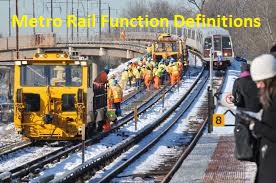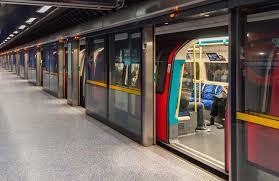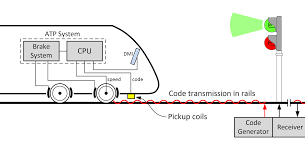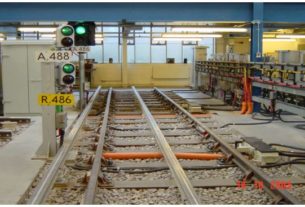Metro Rail Function Definitions
1. “Local Control” means the assumption of the responsibilities of the Traffic Controller for the specific station by a person who is authorized to do so for the time being.
2. “Metro Railway Employee” means an employee duly qualified, possessing a valid certificate of competency and nominated to undertake and perform the duties entrusted to him.
3. “Neutral Section” means a short section of insulated and dead overhead equipment, which separates the areas fed by adjacent sub-station or feeding post for AC traction system.
4. “Normal Direction of Traffic” means traffic moving on the left side track.
5. “Obstruction” with its cognate expressions includes a train, vehicle or obstacle on or fouling a line or any condition which is dangerous to trains.
6. “Operations Control Centre” means the organisation in overall charge of controlling the movement of trains on the main line.
7. “Overhead Equipment” means the electrical conductors over the track together with their associated fittings, insulators and other attachments by means of which they are suspended and registered in position for the purpose of electrical traction.
8. “Passenger Train” means a train intended for the movement of passengers and their baggage.
9. “Permission to Approach” means permission given for a train to enter the Block Section.
10. “Platform Screen Doors” means a system of automated doors synchronised with the train doors which are provided at the platform edge to isolate passengers on platform from track.
11. “Platform Supervisor Booth” means a monitoring cabin on platform for supervisor.
12. “point and trap indicators” means appliances fitted to and working with points to indicate the position in which they are set.
13. “Power Block” means withdrawing traction current or power supply from a particular section.
14. “Proceed Code” means the Automatic Train Protection code other than zero speed code on the Train operator’s console which indicates the target speed.
15. “Railway Board” means the Railway Board as empowered under section 2 of the Indian Railway Board Act, 1905 (4 of 1905).
16. “Receiving Substation” means an electric substation where electric power supply is received from Grid substation and transformed to appropriate voltage for distribution.
17. “Restricted Manual Mode” means a driving mode where train is driven manually and is subjected to Automatic Train Protection in respect of maximum speed limit only.
18. “Rolling Stock Supervisor” means a metro railway employee duly qualified to examine trains and certify their fitness for safe running.
19. “Running Line” means the track used for running trains through and between stations and includes connections, if any, used by a train when entering or leaving stations.
20. “Running Train” means a train which has started on authority to proceed but has not completed its journey.
21. “Run On Sight Mode” means a driving mode where the train is driven manually and is subject to Automatic Train Protection restriction in respect of speed only until Automatic train protection track indications are recognized after which it automatically changes to Coded Manual Mode.
22. “SCADA” means Supervisory Control and Data Acquisition system for the purpose of remote monitoring and control of all traction power supply installations and auxiliary systems.
23. “Secure a Train” means to make a full brake application, close down all driving positions and remove the train operator’s control key and apply parking brakes wherever applicable.
24. “Short Circuiting Device” means such devices provided for safety reasons on each station located in Auxiliary Sub-station/Traction sub-station/station control room to temporarily short circuit the running rails to earth in case the rise of running rail potential exceeds prescribed limits.
25. “Shunting” means the movement of a coach or coaches with or without traction motors or of any other self propelled vehicle, for the purpose of attaching, detaching or transfer or for any other purpose.
26. “Signal” means an indication given to a train operator for controlling the movement of his train.
27. “Signal Engineer” means any metro railway employee in charge of installation and maintenance of any signaling and, or associated telecommunication gears either on track or field or station or on train.



